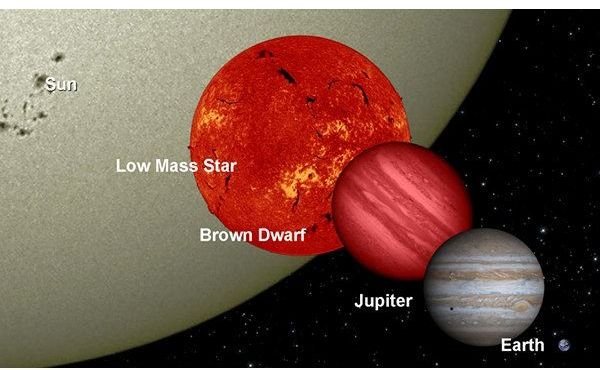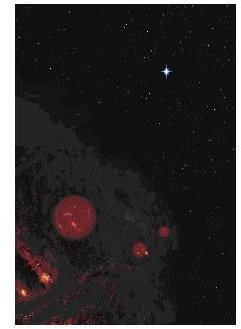Brown Dwarf Stars: Are They Lurking Around Our Solar System?
Lighter Than a Star, Heavier Than a Planet
What is a brown dwarf “star,” and why should we care? The term, first coined in 1975 by astronomer, Jill Tarter, requires a little explaining. But the existence of such a brown dwarf in the outer reaches of our Solar System could affect the security of our home planet.
Size Doesn’t Matter

What matters is mass, not size. A brown dwarf is a gigantic planet which failed to gain sufficient mass to turn on nuclear fusion. It is a failed star, though sometimes it is called a “brown dwarf star.” Calling it a star is a bit of a misnomer. Any brown dwarf may or may not have sparked a nuclear reaction, but could not sustain it.
And why is it called a “dwarf?” Our own Sun is considered to be a “dwarf.” Any star which is in the process of burning hydrogen in its core through nuclear fusion, but not yet any other elements is said to be in the “main sequence” of its lifetime. All such stars are also called “dwarfs.” When a star turns off of the main sequence by burning its newly acquired stash of helium, it becomes first a sub-giant and then a giant star. The most massive stars even enter a stage of development called “super giant.” So, size does enter into the picture, but it’s all driven by mass. The more massive the star, the larger is its potential, but the shorter its life.
At the low end of the stellar mass scale are the red dwarfs. These are by far the coolest of the stars. These are the glowing embers of the galactic fire. Brown dwarfs are cooler still, because they do not have a nuclear fusion core. They glow only from the heat of compression. That heat will dissipate eventually, but it might take trillions of years. Our own Jupiter is still radiating modest amounts of heat from its original formation and compression—some four and a half billion years after the fact.
The line between brown dwarf and red dwarf is somewhat hazy. Chemistry remains one factor which can affect whether an object of a given mass will ignite its nuclear furnace—whether the object is nearly pure hydrogen or heavily dosed with other elements. The line between brown dwarf “stars” and gas giant planets is even less distinct.
Such “dwarfs” are not to be confused with dwarf planets like Pluto, Eris and Sedna. A brown dwarf “star” is a step above gas giant planet.
Mass and Density

When an interstellar cloud first collapses to form stars and planets, the dust and gas become more and more compressed, giving off heat energy from that compression. When the density is thin, the heat radiates away easily. As the density becomes thicker the heat radiation becomes trapped and temperature starts to increase. From this point on, two forces remain at work against each other—gravity, trying to continue the collapse and increase the density, and heat, trying to push outward and decrease the density.
Larger does not always mean more massive. If the Solar System were to go through a dense nebula, Jupiter would gain additional mass and increased gravity. If the increased heat of compression were outpaced by the gravitational attraction, then Jupiter might actually decrease in size somewhere during its new growth, but it would increase in density. Near the end of a star’s life, a red giant would be far larger than it was as a main sequence star. It would have gained its greater size because of a far hotter nuclear furnace, burning helium instead of hydrogen.
So, what is this about a brown dwarf “star” in the Solar System?
The Elusive Planet X
When Pluto was discovered in 1930, it seemed far too light (not massive enough) to explain the orbital problems of Neptune that had plagued astronomers of the late nineteenth and early twentieth centuries. Percival Lowell, founder of Lowell Observatory in Flagstaff, Arizona, had dubbed the missing object, “Planet X,” but Pluto was not it. In the 1990’s, astronomers received revised figures for the mass of Neptune, which eliminated the need for any Planet X as Lowell had described it.
In recent years, the idea of a “Planet X” has been resurrected to explain new anomalies in the outer Solar System. This object is sometimes referred to as “Nemesis” or “The Death Star” for its potential to disrupt the orbits of comets, hurtling them toward the inner Solar System and potentially colliding with Earth.
NASA’s online Astrobiology Magazine explains that two paleontologists have speculated that a 26-million-year cycle of mass extinctions might be caused by just such a “death star.” And, because stars give off visible light, but Nemesis has not yet been found, they speculate that it might be a brown dwarf. NASA’s WISE (Wide-field Infrared Survey Explorer) telescope may just be able to find the brown dwarf “star,” if it’s out there.
The hypothetical brown dwarf “star” has also been given the name, “Tyche” (in Greek mythology, the sister of Nemesis) to distinguish it from earlier theories. John Matese and Daniel Whitmire proposed that their version of unseen object could explain the odd orbit of Sedna, one of Pluto’s fellow “dwarf planets.”
It may take years for scientists to study all of the data received from the WISE telescope. Within that data, they may yet find our solar system’s brown dwarf.
Image Credits
Brown dwarf size comparison, image provided by NASA (public domain).
Brown dwarf hatchlings fresh out of the stellar nursery, image provided by writer / artist (all rights reserved).
References
- Mullen, Leslie. “Getting WISE About Nemesis,” Astrobiology Magazine. NASA, March 11, 2010. http://www.astrobio.net/exclusive/3427/getting-wise-about-nemesis
- “Pluto,” http://en.wikipedia.org/wiki/Pluto
- “Planets beyond Neptune,” http://en.wikipedia.org/wiki/Planets_beyond_Neptune
- Shklovskii, Iosif. Stars: Their Birth, Life, and Death. W. H. Freeman and Company, 1978.